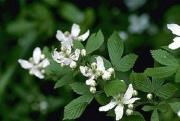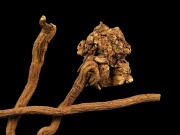Difference between revisions of "Alizarin, natural"
(username removed) |
|||
| Line 4: | Line 4: | ||
== Description == | == Description == | ||
| − | Natural alizarin is a red colorant extracted along with [ | + | Natural alizarin is a red colorant extracted along with [[purpurin|purpurin]] from the roots of the [[madder|madder]] plant, ''Rubia tinctorum'' L.. The chemical name for alizarin is 1,2-dihydroxyanthraquinone. It has been used as a dye and pigment since ancient times. The colorant was first isolated in 1862 by Colin and Robiquet in France. The synthetic form of alizarin was first made in 1868 by Carl Graebe and Carl Lieberman, from [[anthracene|anthracene]]. The natural colorant was no longer used as a textile dye after the commercial introduction of the [[alizarin%2C%20synthetic|synthetic alizarin]] in 1871. |
[[File:03 W.Madder.jpg|thumb|Western madder]] | [[File:03 W.Madder.jpg|thumb|Western madder]] | ||
| + | |||
== Synonyms and Related Terms == | == Synonyms and Related Terms == | ||
Revision as of 09:32, 7 January 2014
Description
Natural alizarin is a red colorant extracted along with Purpurin from the roots of the Madder plant, Rubia tinctorum L.. The chemical name for alizarin is 1,2-dihydroxyanthraquinone. It has been used as a dye and pigment since ancient times. The colorant was first isolated in 1862 by Colin and Robiquet in France. The synthetic form of alizarin was first made in 1868 by Carl Graebe and Carl Lieberman, from Anthracene. The natural colorant was no longer used as a textile dye after the commercial introduction of the synthetic alizarin in 1871.
Synonyms and Related Terms
Rubia tinctorum L.; Natural Red 9, 6, 8, 10, 11, 12; CI 75330; madder; alizarine; 1,2-dihydroxyanthraquinone; seiyo-akane (Jap.); alitsariini (Fin.); alizarine (Fr.); alizarina (Esp.); alizarina (It.); alizarina, natural (Port.)
| Refractive Index | 1.70 |
|---|
Additional Information
° H.Schweppe, J.Winter, "Madder and Alizarin", Artists Pigments, Volume 3, E. West FitzHugh (ed.), Oxford University Press: Oxford, 1997.° Pigments Through the Ages: Madder Lake
Authority
- Artists' Pigments: A Handbook of their History and Characteristics, Elisabeth West FitzHugh, Oxford University Press, Oxford, Vol. 3, 1997 Comment: H.Schweppe, J.Winter, "Madder and Alizarin"
- G.S.Brady, Materials Handbook, McGraw-Hill Book Co., New York, 1971
- R. J. Gettens, G.L. Stout, Painting Materials, A Short Encyclopaedia, Dover Publications, New York, 1966
- Encyclopedia Britannica, http://www.britannica.com Comment: "Alizarin." Encyclopædia Britannica. 2003. 19 Sep, 2003 .
- Reed Kay, The Painter's Guide To Studio Methods and Materials, Prentice-Hall, Inc., Englewood Cliffs, NJ, 1983
- Thomas B. Brill, Light Its Interaction with Art and Antiquities, Plenum Press, New York City, 1980
- R.Feller, M.Curran, C.Bailie, 'Identification of Traditional Organic Colorants Employed in Japanese Prints and Determination of their Rates of Fading', Japanese Woodblock Prints, Allen Memorial Art Museum, Oberlin College, Oberlin, 1984
- Website address 2 Comment: http://www.coloria.net/varita.htm - Finnish name
- Website address 1 Comment: pigments/indiv/technical/alizarin.html RI=1.70 for alizarin, and 1.66 for madder lake
- Art and Architecture Thesaurus Online, http://www.getty.edu/research/tools/vocabulary/aat/, J. Paul Getty Trust, Los Angeles, 2000

